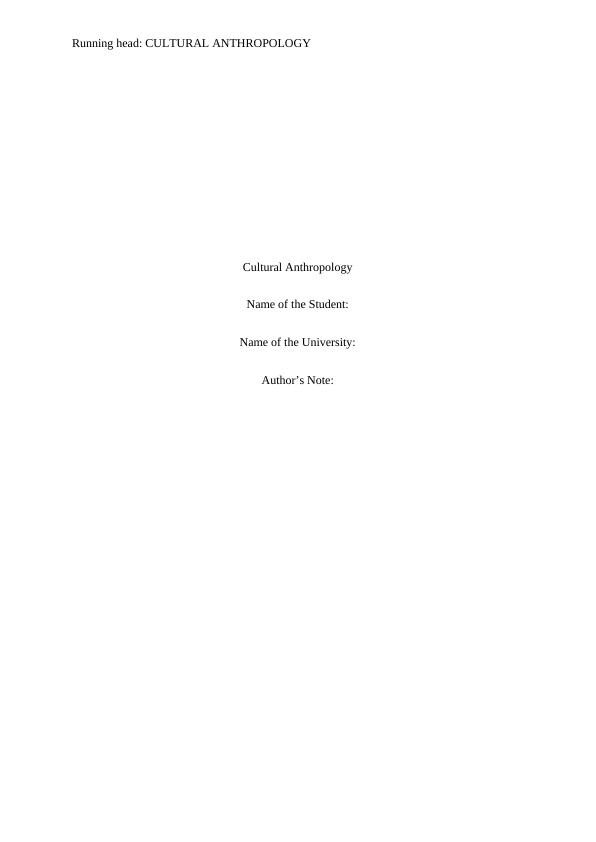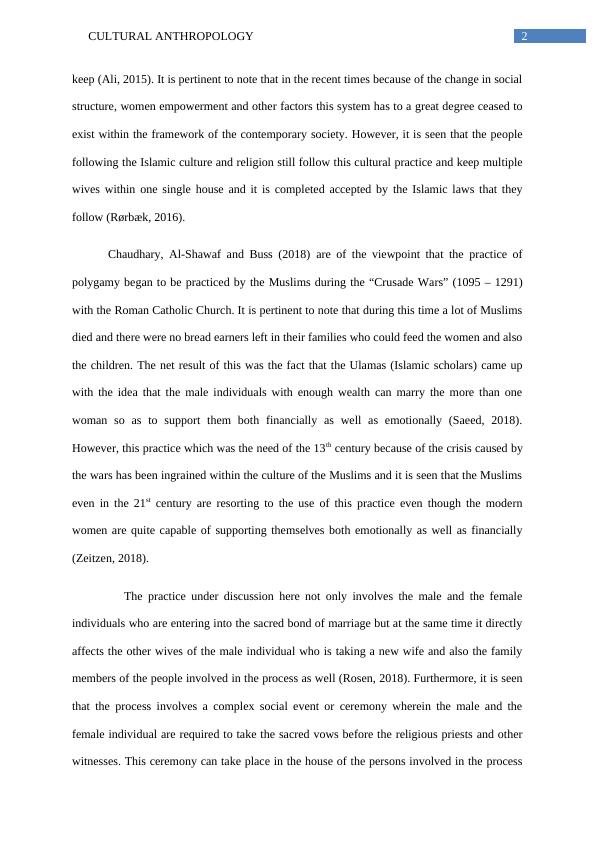Cultural Anthropology .
Added on 2023-05-29
9 Pages2681 Words431 Views
Running head: CULTURAL ANTHROPOLOGY
Cultural Anthropology
Name of the Student:
Name of the University:
Author’s Note:
Cultural Anthropology
Name of the Student:
Name of the University:
Author’s Note:

1CULTURAL ANTHROPOLOGY
As opined by Pipes (2017), culture refers to the accumulation of diverse entities of the
lives of the human beings like their traditions, values, beliefs, practices, habits and others.
Nurmila and Bennett (2015) are of the viewpoint that the construct of culture have been
wielding a substantial amount of influence on the lives of the human beings since the
traditional times. More importantly, it is seen that the practices as well as the behavior of the
human beings are largely dictated by the culture or tradition to which they ascribe. The net
result of this is the fact an analysis of the different cultural traditions and the routine practices
of the individuals are likely to reveal a significant amount of detail regarding the social
history and also the factors which have shaped the present behavior of the modern human
beings (Layish, 2017).
Chaudhary, Al-Shawaf and Buss (2018) argue that culture as well as the cultural
traditions followed by the individuals contributes in a substantial manner towards the identity
or the personality of the individuals. In addition to this, it is seen that the cultural practices of
one culture are often repudiated or criticized by the followers of other cultures. This can be
explained on the basis of the fact that the people from other cultures are unable to
comprehend the significance of the practices or activities followed by the people of a
particular culture or the cultural connotations of these practices. This report will analyze the
cultural practice of polygamy on the basis of my own Canadian culture.
According to Zeitzen (2018), the cultural practice of polygamy refers to the activity of
having more than one spouse or wives by one man. On the other hand, the same practice or
activity when followed by a woman is called by the name of polyandry. Nurmila and Bennett
(2015) are of the viewpoint that this is not a nascent concept and as a matter of fact the
evidence for its usage dates back from the dawn of human civilization. For example, in the
pre-historic times it was seen that the male members of the tribes used to keep multiple wives
and their prestige as well as honor depended on the number of wives that they were able to
As opined by Pipes (2017), culture refers to the accumulation of diverse entities of the
lives of the human beings like their traditions, values, beliefs, practices, habits and others.
Nurmila and Bennett (2015) are of the viewpoint that the construct of culture have been
wielding a substantial amount of influence on the lives of the human beings since the
traditional times. More importantly, it is seen that the practices as well as the behavior of the
human beings are largely dictated by the culture or tradition to which they ascribe. The net
result of this is the fact an analysis of the different cultural traditions and the routine practices
of the individuals are likely to reveal a significant amount of detail regarding the social
history and also the factors which have shaped the present behavior of the modern human
beings (Layish, 2017).
Chaudhary, Al-Shawaf and Buss (2018) argue that culture as well as the cultural
traditions followed by the individuals contributes in a substantial manner towards the identity
or the personality of the individuals. In addition to this, it is seen that the cultural practices of
one culture are often repudiated or criticized by the followers of other cultures. This can be
explained on the basis of the fact that the people from other cultures are unable to
comprehend the significance of the practices or activities followed by the people of a
particular culture or the cultural connotations of these practices. This report will analyze the
cultural practice of polygamy on the basis of my own Canadian culture.
According to Zeitzen (2018), the cultural practice of polygamy refers to the activity of
having more than one spouse or wives by one man. On the other hand, the same practice or
activity when followed by a woman is called by the name of polyandry. Nurmila and Bennett
(2015) are of the viewpoint that this is not a nascent concept and as a matter of fact the
evidence for its usage dates back from the dawn of human civilization. For example, in the
pre-historic times it was seen that the male members of the tribes used to keep multiple wives
and their prestige as well as honor depended on the number of wives that they were able to

2CULTURAL ANTHROPOLOGY
keep (Ali, 2015). It is pertinent to note that in the recent times because of the change in social
structure, women empowerment and other factors this system has to a great degree ceased to
exist within the framework of the contemporary society. However, it is seen that the people
following the Islamic culture and religion still follow this cultural practice and keep multiple
wives within one single house and it is completed accepted by the Islamic laws that they
follow (Rørbæk, 2016).
Chaudhary, Al-Shawaf and Buss (2018) are of the viewpoint that the practice of
polygamy began to be practiced by the Muslims during the “Crusade Wars” (1095 – 1291)
with the Roman Catholic Church. It is pertinent to note that during this time a lot of Muslims
died and there were no bread earners left in their families who could feed the women and also
the children. The net result of this was the fact that the Ulamas (Islamic scholars) came up
with the idea that the male individuals with enough wealth can marry the more than one
woman so as to support them both financially as well as emotionally (Saeed, 2018).
However, this practice which was the need of the 13th century because of the crisis caused by
the wars has been ingrained within the culture of the Muslims and it is seen that the Muslims
even in the 21st century are resorting to the use of this practice even though the modern
women are quite capable of supporting themselves both emotionally as well as financially
(Zeitzen, 2018).
The practice under discussion here not only involves the male and the female
individuals who are entering into the sacred bond of marriage but at the same time it directly
affects the other wives of the male individual who is taking a new wife and also the family
members of the people involved in the process as well (Rosen, 2018). Furthermore, it is seen
that the process involves a complex social event or ceremony wherein the male and the
female individual are required to take the sacred vows before the religious priests and other
witnesses. This ceremony can take place in the house of the persons involved in the process
keep (Ali, 2015). It is pertinent to note that in the recent times because of the change in social
structure, women empowerment and other factors this system has to a great degree ceased to
exist within the framework of the contemporary society. However, it is seen that the people
following the Islamic culture and religion still follow this cultural practice and keep multiple
wives within one single house and it is completed accepted by the Islamic laws that they
follow (Rørbæk, 2016).
Chaudhary, Al-Shawaf and Buss (2018) are of the viewpoint that the practice of
polygamy began to be practiced by the Muslims during the “Crusade Wars” (1095 – 1291)
with the Roman Catholic Church. It is pertinent to note that during this time a lot of Muslims
died and there were no bread earners left in their families who could feed the women and also
the children. The net result of this was the fact that the Ulamas (Islamic scholars) came up
with the idea that the male individuals with enough wealth can marry the more than one
woman so as to support them both financially as well as emotionally (Saeed, 2018).
However, this practice which was the need of the 13th century because of the crisis caused by
the wars has been ingrained within the culture of the Muslims and it is seen that the Muslims
even in the 21st century are resorting to the use of this practice even though the modern
women are quite capable of supporting themselves both emotionally as well as financially
(Zeitzen, 2018).
The practice under discussion here not only involves the male and the female
individuals who are entering into the sacred bond of marriage but at the same time it directly
affects the other wives of the male individual who is taking a new wife and also the family
members of the people involved in the process as well (Rosen, 2018). Furthermore, it is seen
that the process involves a complex social event or ceremony wherein the male and the
female individual are required to take the sacred vows before the religious priests and other
witnesses. This ceremony can take place in the house of the persons involved in the process

End of preview
Want to access all the pages? Upload your documents or become a member.
Related Documents
Comparison of Monotheistic and Polytheistic Belief Systems and Their Attitudes Towards the Environmentlg...
|11
|3633
|215
Religious Conflicts and Religionlg...
|8
|2418
|204
Role of Khadijah as the Ideal Wife of Prophet Muhammadlg...
|8
|1883
|45
LGBTQ Issues and Nature Versus Nurturelg...
|12
|3721
|271
Media and Identitylg...
|10
|3219
|70
Intro to Cultural Anthropology: Study of Human Beliefs and Culturelg...
|7
|1910
|76
